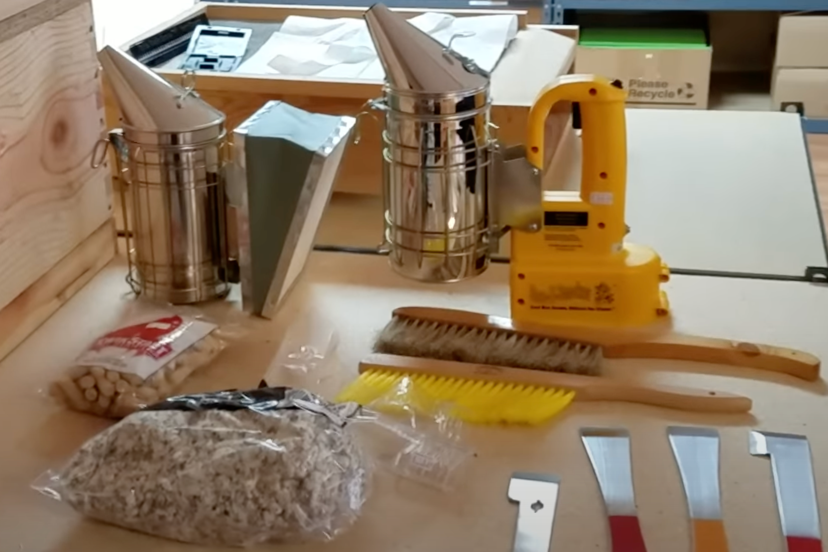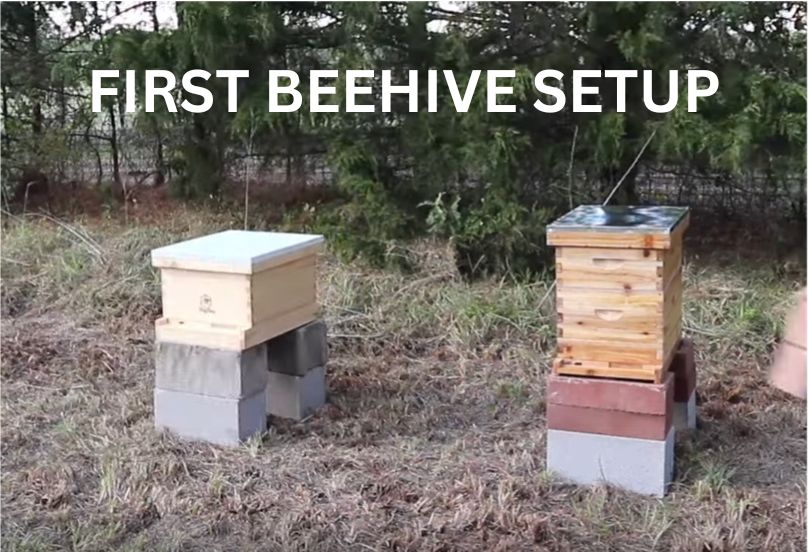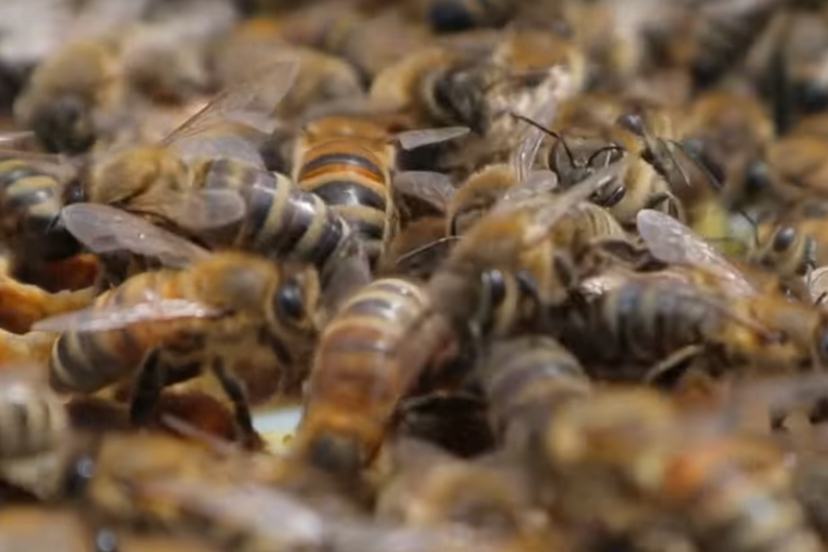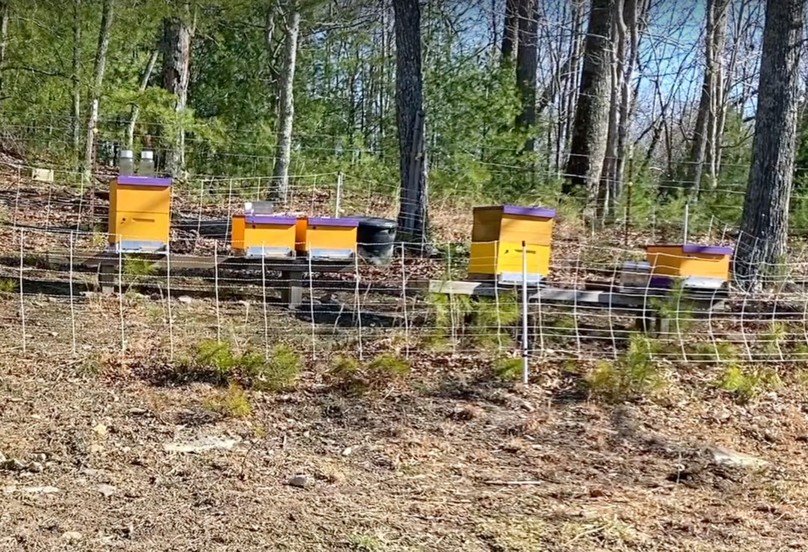Welcome, bee health champions! So, you’ve mastered the art of beekeeping, but now your little buzzers are looking under the weather? Don’t worry, you’re not alone in this sticky situation.
Did you know that a single diseased bee can infect an entire colony faster than gossip spreads at a high school reunion? It’s true!
In this guide, we’ll explore the most common bee ailments, from the dreaded Varroa mite to the mysteriously named “chalkbrood.” We’ll turn you from a worried bee parent into a confident hive doctor in no time. So, grab your magnifying glass, put on your detective hat, and let’s dive into the world of bee maladies!
- 1. Varroa Mites: The Vampire of the Bee World
- 2. American Foulbrood: The Hive's Worst Nightmare
- 3. European Foulbrood: The Lesser Evil
- 4. Nosema: The Silent Killer
- 5. Chalkbrood: The Fungal Invader
- 6. Sacbrood Virus: The Brood Impersonator
- 7. Deformed Wing Virus: The Visible Threat
- 8. Small Hive Beetle: The Unwelcome Guest
- 9. Wax Moths: The Comb Destroyers
- 10. Emerging Threats: New Diseases on the Horizon
- The Final Buzz
1. Varroa Mites: The Vampire of the Bee World
When I first heard about Varroa mites, I thought, “How bad could a tiny bug be?” Turns out, pretty bad! These little vampires are beekeepers’ nightmares.

Identifying Varroa Infestations
Identifying infestations is like playing detective with a magnifying glass. These sneaky mites are about pinhead-sized and reddish-brown. I use a white sticky board under the hive – it’s like setting a tiny bug trap.
Pro tip: The sugar shake method is great for checking mite levels. You shake bees in powdered sugar and count the fallen mites. It’s like giving your bees a sweet spa day… that ends in pest control.

Natural and Chemical Treatment Options
For treatment, there’s the natural route and the chemical highway. I started with essential oils, thinking I’d solve it with fancy bee aromatherapy. The mites were not impressed.
Now I use a mix of methods. Screened bottom boards are great – it’s like giving mites a one-way ticket out. Drone frame removal is another trick. Mites love drone brood, so removing it is like taking away their favorite buffet.
For chemical treatments, always follow instructions! I once thought, “If a little is good, more must be better.” Yeah… no. Ended up with some very unhappy, slightly crispy bees.
Prevention Strategies for Long-Term Control
Prevention is key for long-term control. I breed for hygienic behavior – bees that groom each other and remove mites. It’s like having a hive full of tiny beauticians.
Regular monitoring is crucial. I check for mites as religiously as I check my phone. Maybe more so. It’s become an obsession. I once found myself explaining mite check methods to my hair dress. Pretty sure he now thinks I have a weird bug fixation.
Remember, what works in one hive might not work in another. It’s all about observing and adapting. I’ve become something of a mite whisperer over the years.
Here is a great video demonstrating the sugar shake method and explaining everything about Varroa Mites and honeybees.
2. American Foulbrood: The Hive’s Worst Nightmare
When I first heard about American Foulbrood (AFB), I thought it sounded like a bad rock band. Turns out, it’s more like a horror movie for bees. Here is a picture of a very spotty brood pattern called the shot gun which is classic brood pattern for the American Foulbrood

Recognizing AFB Symptoms
Recognizing symptoms is like being a bee detective. Sunken, perforated cappings and a horrible smell – like a gym locker filled with old socks – are dead giveaways.

The rope test is the clincher. You stick a twig into a diseased cell, and when you pull it out, the goo stretches like melted cheese. It can be up to 5cm long. Fascinating and horrifying at the same time.

Another classic sign is scaling on the lower cell wall that is very difficult to remove.

Legal Requirements for Reporting and Treatment
Legal requirements are strict. When you find AFB, you’ve got to report it faster than gossip spreads at a church picnic. I remember making that first call to the bee inspector. Felt like I was turning myself in for a crime!
Treatment? Well, that’s a misnomer. There’s no treatment, just containment. It’s like the bee equivalent of a zombie apocalypse – once it starts, you’ve got to stop it from spreading.
Sterilization and Hive Destruction Procedures
Sterilization and hive destruction procedures are grim. Burning an infected hive feels like attending a bee funeral. It’s heartbreaking, but necessary. You’ve got to be thorough – AFB spores are tougher than a two-dollar steak.
Prevention is your best bet. I’m now paranoid about apiary hygiene. I sterilize my tools more often than a surgeon. My family thinks I’ve gone off the deep end, but hey, better safe than sorry!
Remember, AFB spores can live for decades. It’s like the bee disease equivalent of a doomsday prepper – always ready to spring back to life.
Dealing with AFB is about vigilance and quick action. It’s not fun, but it’s part of responsible beekeeping. Don’t be surprised if you find yourself obsessively inspecting every brood cell like you’re looking for the bee version of Waldo.
3. European Foulbrood: The Lesser Evil
When I first encountered European Foulbrood (EFB), I thought, “Great, another bee disease with a fancy name.” But EFB is like AFB’s mischievous little brother – not as deadly, but still a pain.
Differentiating EFB from AFB
Differentiating EFB from AFB is like playing “Spot the Difference.” EFB-infected larvae are like deflated balloons – twisted, yellow or brown, and sad-looking. No rope test drama here. The smell’s different too – more sour milk than locker room nightmare.

Antibiotic Treatments and Their Controversies
Antibiotic treatments are controversial – like bringing up politics at Thanksgiving dinner. I’ve used them before but I don’t like to for many reasons but one big one is that the antibiotic ends up in the honey. Plus, there’s the resistance worry. I once felt like I was running a tiny bee pharmacy!

Strengthening Colonies to Resist EFB
Strengthening colonies is key to fighting EFB. It’s like boosting an immune system for an entire bee society. I focus on good nutrition, reducing stress (yes, bees get stressed), and maintaining strong queens. I had a weak colony that kept getting EFB – turns out they were queenless. New queen, and bam! No more EFB. Bee magic!
Make sure that you clean your tools regularly, hygiene is crucial. EFB can recur, unlike AFB. It’s like that annoying cold that keeps coming back. I’ve learned to be vigilant, checking hives more often than my phone.
Dealing with EFB is about balance – be alert without panicking, proactive without overreacting. It’s like being a bee parent – you want to protect them, but you can’t wrap them in bubble wrap.
4. Nosema: The Silent Killer
When I first heard about Nosema, I thought it sounded like a fancy Italian dessert. Turns out, it’s more like a nasty stomach bug for bees. This microscopic menace can sneak up on you faster than a bee on a fresh flower.
Types of Nosema and Their Impact
There are two types: Nosema apis (Northern climates) and ceranae. Apis is the old-school villain, causing bee dysentery. I once had a hive with apis, and the front looked like a very unfortunate Jackson Pollock painting. Ceranae is more subtle but potentially more dangerous – the ninja of bee diseases.

Diagnosing Nosema in Your Hive
Diagnosing Nosema is tricky. Signs are subtle – decreased honey production, slow spring build-up, and bees that look like they’ve had one too many fermented nectars. The only sure way to diagnose is with a microscope. First time I looked at bee guts under one, I felt like a mad scientist!
Treatment Options and Preventive Measures
Treatment options have changed. Now, it’s all about prevention and strengthening the colony. I focus on good nutrition, like ensuring diverse pollen sources. It’s like being a bee nutritionist – “Eat your greens… or yellows, or purples!”
Keeping equipment clean is crucial. I sterilize my tools so much, I’m practically a part-time janitor. Some swear by natural treatments like thyme oil. I tried it once – my bees smelled like an Italian kitchen for weeks!
Regular monitoring and preventive measures are key. Good ventilation is like giving your bees constant fresh air.
Remember, stress can make bees more susceptible to Nosema. Keeping colonies strong and happy is your best defense. It’s like being a bee therapist – “Tell me about your relationship with the queen. How does that make you feel?”
Dealing with Nosema is about vigilance and good practices. Just don’t be surprised if you find yourself peering anxiously at bee poop, wondering if it looks “normal.” Welcome to the glamorous world of Nosema management!
5. Chalkbrood: The Fungal Invader
When I first encountered chalkbrood, I thought someone had spilled little white pebbles in front of my hive. Turns out, those “pebbles” were mummified bee larvae. Talk about a macabre welcome mat!
Identifying Chalkbrood Mummies
Identifying chalkbrood mummies is like playing a grotesque game of “I Spy.” These chalk-like lumps are bee larvae killed by the Ascosphaera apis fungus. My first major outbreak looked like someone had emptied a bag of Tic Tacs in front of the hive. Not exactly the minty fresh experience you want in beekeeping!
Mummies come in white or black, depending on spore production. Finding black ones is like discovering your bees have been invaded by tiny, evil marshmallows.
Environmental Factors Contributing to Chalkbrood
Environmental factors are crucial. Chalkbrood loves cool, damp conditions – like a mushroom’s perfect day. I once had a hive in a shady, damp spot. It was chalkbrood city! Moved it to a sunnier location, and it was like I’d performed a bee exorcism.
Stress is another factor. Overcrowding, poor nutrition, or a weak queen can all lead to a chalkbrood party. I once stressed a hive during an overzealous inspection. Came back to find more chalkbrood than bees. Lesson learned: sometimes less fussing is more.
Management Techniques to Reduce Incidence
Management techniques focus on creating an unfriendly environment for the fungus. Good ventilation is key. I’ve become a bee HVAC expert. Keeping colonies strong is crucial – like having a bee army ready to fight fungal invaders.
Replacing old comb helps too. Old comb can harbor spores like teenagers harbor dirty socks. Some beekeepers swear by adding apple cider vinegar to syrup as prevention. I tried this – my bees smelled like a salad for weeks!
Remember, while not usually a colony killer, chalkbrood can significantly weaken a hive. It’s like a persistent cold – not deadly, but a drag on productivity.
Managing chalkbrood is about creating a healthy, stress-free environment for your bees. Just don’t be surprised if you find yourself obsessively checking the forecast and moving hives around like furniture. Welcome to chalkbrood management, where fungus is the enemy and sunny days are your best friend!
6. Sacbrood Virus: The Brood Impersonator
When I first encountered sacbrood, I thought my bees had started a weird mummy cosplay trend. Turns out, it’s a virus that turns bee larvae into tiny, fluid-filled sacs. Nature’s cruel version of water balloons.
Recognizing Sacbrood Symptoms
Recognizing symptoms is like being a bee pediatrician. Infected larvae look like they’re wearing ill-fitting yellow raincoats, changing from pearly white to yellowish-brown. They slip out of cells like tiny, gooey sleeping bags. The first time I saw this, I thought I’d invented a bee slip-n-slide!
Cappings over infected cells often look sunken and perforated, like someone’s been playing whack-a-mole on your brood comb. I once spent an entire afternoon playing “spot the sacbrood.” My family thought I’d lost it, but hey, vigilance is key!
Natural Recovery and Hive Management
Natural recovery is the game here. Unlike other diseases requiring intervention, sacbrood often clears up if the colony is strong enough. It’s the bee equivalent of “walk it off, champ!”
Management is about supporting natural defenses. Good nutrition is crucial. I became obsessed with providing diverse pollen sources, planting flowers everywhere like a bee-crazed Johnny Appleseed.
Reducing stress is important too. I learned to be gentler during inspections. No more treating the hive like a Rubik’s cube.
Preventing Sacbrood Outbreaks
Prevention is mostly good beekeeping practices. Keep equipment clean – I now clean my hive tool so often, I’m considering naming it “Mr. Sparkle.”
Maintaining strong colonies with young, vigorous queens helps. I became a queen-quality fanatic, always checking her performance and “royal swagger.”
Remember, sacbrood can spread through robbing, so watch weak hives. I once had a weak hive become a sacbrood superspreader – like a bee zombie apocalypse movie. Dealing with sacbrood is about patience and good management. It’s rarely fatal, but can drag productivity.
7. Deformed Wing Virus: The Visible Threat
When I first saw a bee with deformed wing virus (DWV), I thought it had a run-in with a tiny bee steamroller. Poor thing looked like it was wearing crumpled paper airplanes instead of wings!
Connection Between DWV and Varroa Mites
The connection between DWV and Varroa mites is like a twisted buddy cop movie where both are villains. Varroa spreads DWV faster than gossip at a church picnic. I once thought I had Varroa under control, only to find bees that looked like they’d been through a wing wringer. Rude awakening!
Identifying Affected Bees
Identifying affected bees is like playing a sad game of “spot the difference.” Healthy bees have sleek wings. DWV bees? Wings look paper-shredded. They often can’t fly, crawling around like tiny, sad roombas.
Strategies for Minimizing DWV Impact
Strategies for minimizing DWV impact all come back to Varroa control. It’s like playing whack-a-mole with vampiric ticks. I’ve become obsessed with mite counts, peering at sticky boards like they’re modern art.
Keeping colonies strong is crucial. A robust colony is like an immune system on steroids. I focus on good nutrition, ensuring a diverse pollen buffet. I’ve even started talking to my flowers, encouraging more pollen. Neighbors think I’m nuts, but whatever works!
Regular requeening helps too. Young queens lay eggs like there’s no tomorrow, outpacing the virus. I’ve become a queen connoisseur, always seeking that perfect royal jelly. Hygiene is key. I clean my equipment all the time.
Remember, stress can worsen DWV. I’ve learned gentler inspections. No more treating hives like Rubik’s cubes. The bees appreciate it; I swear I hear tiny sighs of relief. Managing DWV is about vigilance, good practices, and lots of mite control.
8. Small Hive Beetle: The Unwelcome Guest
When I first spotted a small hive beetle, I thought, “Aw, cute little bug!” Then I realized it was like finding a rat in your kitchen. Not so cute anymore!
Detecting Small Hive Beetle Infestations
Detecting these invaders is like playing hide and seek with tiny ninjas. They’re sneaky, hiding in cracks faster than a teen stashing their phone. I once spent an entire afternoon playing “spot the beetle.” My back hurt, eyes crossed, but I found those buggers!
The real tell-tale sign? Slimy, fermented honey. The first time I saw that, I thought my bees had started homebrewing. Nope, just beetle larvae having a pool party in my frames. Gross.
Traps and Baits for Control
Beekeepers get creative with traps and baits. My favorite? The CD case trap. Fill old AOL discs with oil – instant beetle slip-n-slide! Some swear by diatomaceous earth. I tried it once and looked like I’d lost a fight with a flour bag. The bees were not impressed with my new look.
Hive Management to Discourage Beetles
Hive management is about making your hive a beetle’s nightmare. Keep it strong, clean, and sunny. Beetles love damp, dark places – like tiny, evil vampires.
I’ve become obsessed with ventilation and removing excess space. My neighbors probably think I’m running a bee air conditioning business.
Some put hives on concrete blocks to discourage pupation. I tried this and nearly threw out my back. Note to self: lift with legs, not back!
Remember, a strong colony can usually keep beetles in check. It’s like having a tiny bee army ready to fight. I imagine my bees in camo outfits, planning their defense strategies.
Managing beetles is about vigilance, creativity, and humor. If you can’t laugh at a beetle slip-n-sliding into an oil trap, what can you laugh at?
9. Wax Moths: The Comb Destroyers
When I first encountered wax moths, I thought my hive had been invaded by tiny, evil butterflies. Turns out, these comb-munching menaces are more like the Godzilla of the bee world.

Differentiating Between Greater and Lesser Wax Moths
Differentiating between greater and lesser wax moths is like playing “spot the difference” with troublemakers. The greater is bigger and badder; the lesser is its sneaky cousin. I once spent an afternoon squinting at moths, feeling like an entomologist gone mad.
Protecting Stored Comb from Infestation
Protecting stored comb is crucial, unless you want swiss cheese frames. I learned this when my stored supers became a wax moth buffet. Now, I freeze frames before storage. It’s like running a top-secret bee frame cryogenics lab.
Some use paradichlorobenzene crystals, but that stuff smells worse than gym socks after a marathon. I prefer the deep-freeze method.
In-Hive Management for Wax Moth Control
In-hive management is all about strong colonies. A robust hive is like a tiny army fending off invaders. I focus on healthy colonies with good queens, playing bee personal trainer and life coach.
Reducing excess space is crucial. Wax moths love unused areas. I’ve mastered bee space Tetris, ensuring every inch is bee-approved and moth-disapproved.
Regular inspections are key. I check hives more often than a teen checks their phone. It’s obsessive – I once explained wax moth signs to my cat.
Some swear by traps baited with vinegar or banana peels. I tried this; my apiary smelled like weird fruit salad for weeks, but it helped!
Remember, wax moths are usually a symptom of other problems. They’re nature’s clean-up crew, just overzealous.
10. Emerging Threats: New Diseases on the Horizon
Just when I thought I had a handle on bee diseases, along come new threats that make me feel like I’m playing blindfolded whack-a-mole. Let me tell you about some emerging menaces that keep us beekeepers up at night.
Asian Giant Hornet and Its Potential Impact
First up, the Asian Giant Hornet, aka the “Murder Hornet.” When I heard that name, I thought it was a B-grade horror movie title. Turns out, it’s real and about as welcome in a beehive as a bull in a china shop.
These hornets are the linebackers of the insect world – big, mean, and capable of decimating a hive faster than you can say “honey.” I’ve started practicing karate moves, just in case. My neighbors think I’ve lost it, but a beekeeper’s gotta do what a beekeeper’s gotta do!
Chronic Bee Paralysis Virus: A Growing Concern
Next worry: Chronic Bee Paralysis Virus (CBPV). This virus is spreading faster than gossip at a church picnic. It causes bees to tremble and lose flight ability. The first time I saw it, I thought my bees had gotten into fermented nectar. Nope, just a virus turning them into tiny, fuzzy zombies.
The scary part? How fast CBPV spreads. It’s like a viral TikTok dance – one minute everything’s normal, the next your whole hive is doing the shaky-shake.
Staying Informed About New Bee Health Challenges
Staying informed is crucial. I’ve become a regular at beekeeping conferences, forums, and workshops. My family thinks I’ve joined a cult, but it’s just my way of staying ahead.
I subscribe to more beekeeping journals than streaming services. My bathroom reading is 90% bee health updates. It’s a bit much, but knowledge is power!
Networking with other beekeepers is key. We’re like a secret society, sharing intel on the latest threats. I’ve got beekeeping friends on speed dial, ready to share the latest buzz.
Remember, in bee health, what you don’t know can hurt your hives. Stay curious, stay informed, and maybe invest in a good magnifying glass. You never know when you’ll need to play bee detective!
The Final Buzz
Congratulations! You’re now armed with the knowledge to be the Sherlock Holmes of bee health. Remember, a healthy hive is a happy hive, and early detection is key to managing these pesky problems.
Keep your eyes peeled, your smoker ready, and don’t be afraid to call in the experts when things get too sticky. With vigilance and care, you’ll keep your colonies buzzing along nicely. Now go forth, tend to your bees, and may your hives be forever free of these unwelcome visitors!




